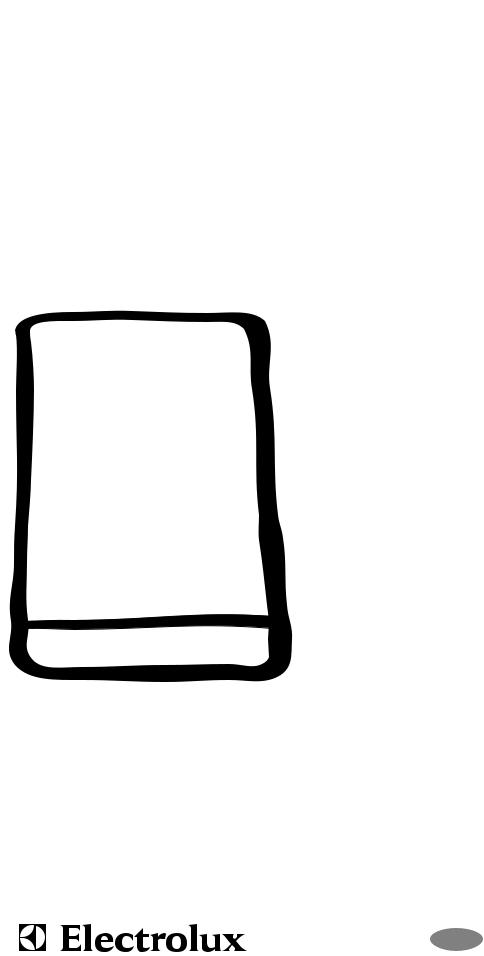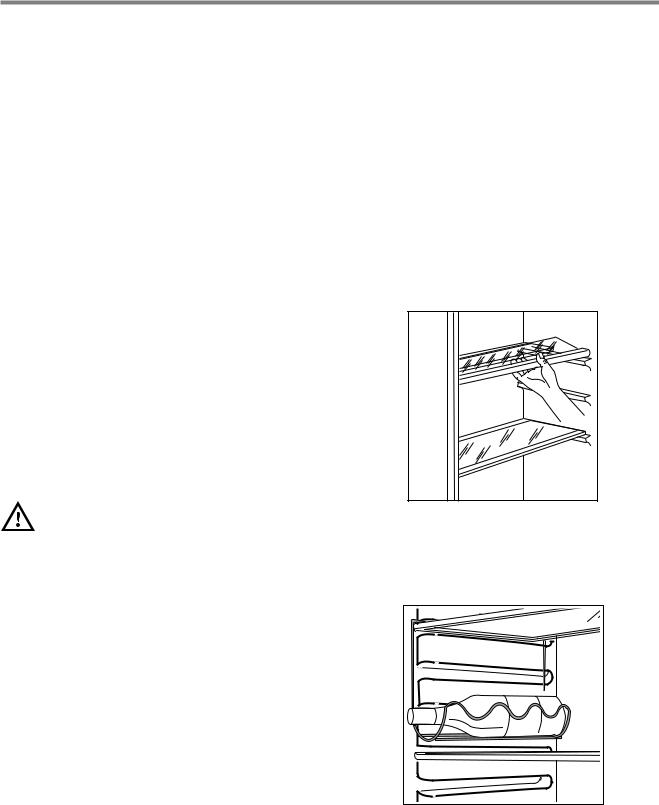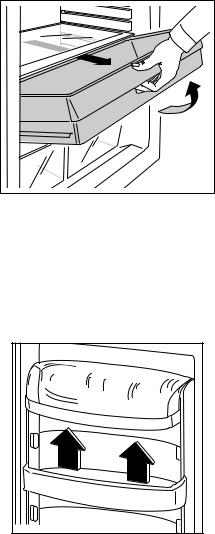Electrolux ERN 1673, ERN 2372 User Manual

r e f r i g e r a t o r
INSTRUCTION BOOKLET
ERN 1673 |
ERN 2372 |
UK
2222 746-33

 Important Safety Instructions
Important Safety Instructions
These warnings are provided in the interests of your safety. Ensure that you understand them all before installing or using this appliance. Your safety is of paramount importance. If you are unsure about any of the meanings of these warnings contact the Customer Care Department.
Prior to Installation
•Check the appliance for transport damage. Under no circumstance should a damaged appliance be installed. In the event of damage please contact your retailer.
Installation
•This appliance is heavy. Care should be taken when moving it.
•It is dangerous to alter the specifications or attempt to modify this product in any way.
•Ensure that the appliance does not stand on the electrical supply cable.
Important: if the supply cable is damaged, it must be replaced by a cable available from the manufacturer or your local Service Force Centre.
•Any electrical work required to install this appliance should be carried out by a qualified electrician or competent person.
•Parts which heat up should not be exposed. Whenever possible, the back of the appliance should be close to a wall, but leaving the required distance for ventilation, as stated in the installation instructions.
•The appliance should be left for 2 hours after installation before it is turned on, in order to allow the refrigerant to settle.
Refrigerant
•The refrigerant isobutane (R600a) is contained within the refrigerant circuit of the appliance, a natural gas with a high level of environmental compatibility, which is nevertheless flammable.
•During transportation and installation of the appliance, be certain that none of the components of the refrigerant circuit become damaged.
•If the refrigerant circuit should become damaged:
-avoid open flames and sources of ignition.
-thoroughly ventilate the room in which the appliance is situated.
Child Safety
•Do not allow children to tamper with the controls or play with the product.
•There is a risk of suffocation! Keep packaging material away from children!
General Safety
•This appliance contains hydrocarbons in its cooling unit; maintenance and recharging must therefore only be carried out by authorised technicians.
•Take utmost care when handling your appliance so as not to cause any damages to the cooling unit with consequent possible fluid leakages.
•The appliance must not be located close to radiators or boilers.
•Avoid prolonged exposure of the appliance to direct sunlight.
•Do not use other electrical appliances (such as ice cream makers) inside of refrigerating appliances.
During Use
•This appliance is designed for domestic use only, specifically for the storage of edible foodstuffs. It is not intended for commercial or industrial use.
•Containers with flammable gases or liquids can leak at low temperatures. Do not store any containers with flammable materials, such as spray cans, fire extinguisher refill cartridges etc. in the refrigerator.
Maintenance and Cleaning
•Before cleaning, always switch off the appliance and disconnect from the electrical supply.
•When unplugging always pull the plug from the mains socket, do not pull on the cable.
Servicing
•This product should be serviced by an authorised engineer and only genuine spare parts should be used.
•Under no circumstances should you attempt to repair the appliance yourself. Repairs carried out by inexperienced persons may cause injury or serious malfunctioning. Contact your local Service Force Centre.
2

At the end of the Appliance Life
•When disposing of your appliance use an authorised disposal site.
The symbol  on the product or on its packaging indicates that this product may not be treated as household waste. Instead it shall be handed over to the applicable collection point for the recycling of electrical and electronic equipment. By ensuring this product is disposed of correctly, you will help prevent potential negative
on the product or on its packaging indicates that this product may not be treated as household waste. Instead it shall be handed over to the applicable collection point for the recycling of electrical and electronic equipment. By ensuring this product is disposed of correctly, you will help prevent potential negative
consequences for the environment and human health, which could otherwise be caused by inappropriate waste handling of this product. For more detailed information about recycling of this product, please contact your local city office, your household waste disposal service or the shop where you purchased the product.
•Remove the plug and ensure that any locks or catches are removed, to prevent young children being trapped inside.
Contents
Instructions for the User
Important Safety Instructions . . . . . . . . . . . . . . . .2
Operation . . . . . . . . . . . . . . . . . . . . . . . . . . . . . . . .4
Before use / Setting the temperature . . . . . . . . . . .4 Fresh food refrigeration . . . . . . . . . . . . . . . . . . . . .4
Bottle/Can shelf . . . . . . . . . . . . . . . . . . . . . . . . . . .4
Groceries drawer / The door shelves . . . . . . . . . . .5 Normal operating sounds . . . . . . . . . . . . . . . . . . . .5
Health and safety guidelines . . . . . . . . . . . . . . . . |
.6 |
Defrosting . . . . . . . . . . . . . . . . . . . . . . . . . . . . . . . |
.7 |
Maintenance and Cleaning . . . . . . . . . . . . . . . . . . |
7 |
Internal cleaning / Changing the light bulb . . . . . . |
7 |
Something not Working? . . . . . . . . . . . . . . . . . . . |
8 |
Service and Spare Parts . . . . . . . . . . . . . . . . . . . . |
9 |
Customer Care Department . . . . . . . . . . . . . . . . . .9
Guarantee Conditions . . . . . . . . . . . . . . . . . . . . . .10
Instructions for the Installer
Technical specifications . . . . . . . . . . . . . . . . . . . .11
Installation . . . . . . . . . . . . . . . . . . . . . . . . . . . . . .11
Positioning . . . . . . . . . . . . . . . . . . . . . . . . . . . . . .11
Door reversal . . . . . . . . . . . . . . . . . . . . . . . . . . . . .12
Electrical Connection . . . . . . . . . . . . . . . . . . . . . .13
Building in . . . . . . . . . . . . . . . . . . . . . . . . . . . . . . .14
3

Operation
Before use
Remove all securing tapes. Wash inside the appliance with lukewarm water and bicarbonate of soda (5 ml to 0.5 litre of water). Do not use soap or detergent as the smell may linger. Dry thoroughly.
Setting the temperature
The temperature inside the refrigerator is regulated by a thermostat control knob with 6 temperature positions and one «OFF» (O) position.
Position 1 = minimum coldness Position 6 = maximum coldness
Turn the thermostat control knob to the required position.
An intermediate position is usually the most suitable, although the temperature will be affected by:
•Room temperature
•How often the door is opened
•How much food is stored
•Position of the appliance
In determining the correct temperature control setting all these factors have to be considered and some experimentation may be necessary.
When altering the temperature setting, allow 24 hours for the temperature to stablise before making further changes.
Important
During prolonged periods of abnormally hot weather, if the thermostat is set on too high a number, the cooling system may operate continuously and the fridge cooling plate may not defrost. Turning the knob to a lower number will cause the automatic defrosting to resume.
If you wish to return to a lower temperature, turn the thermostat knob to a higher number, however you should turn the setting lower occasionally to allow automatic defrosting.
Fresh food refrigeration
To obtain the best performance, do not store warm food or evaporating liquids in the refrigerator; do cover or wrap the food, particularly if it has a strong flavour.
Do not cover the shelves with any protective material, such as paper, cardboard or plastic, which may obstruct the air circulation through them.
To help you use your refrigerator correctly, here are some more useful hints:
Raw meat (beef, pork, lamb & chicken or poultry): wrap in polythene bags and place on top of the salad bin.
Meat can only be stored safely in this way for one or two days at the most.
Fruit & vegetables: these should be thoroughly cleaned and placed in the bottom salad bin.
Butter & cheese: these should be placed in special airtight containers or wrapped in aluminium foil or polythene bags to exclude as much air as possible.
Milk bottles: these should have a cap and should be stored in the bottle rack on the door.
The walls of the refrigerator are equipped with runners so that shelves can be positioned as desired.
For better use of space, the front half-shelves can lie over the rear ones (see fig.).
D338
Bottle/Can Shelf (only for ERN 2372)
•To insert or move the bottle/can shelf, pull out the corresponding storage shelf.
•Ensure that the bottle or cans do not touch the rear wall of the appliance or, when the door is closed, the door shelf.
•Always lay bottles in the shelf with the top to the front. Small bottles and cans can be placed crossways in the holder.
Attention! Place only unopened bottles or cans horizontally.
4

Groceries Drawer (only for ERN 2372)
Some models have a groceries drawer mounted on rollers above the fruit and vegetable trays. When stored here groceries are more easily accessible.
The groceries drawer may be removed:
•Pull the groceries drawer fully forwards then lift it upwards and remove.
• To replace, please reverse the procedure.
The door shelves
To permit storage of food packages of various sizes the central door shelf can be adjusted in height.
To do this proceed as figure.
For more thorough cleaning, the top door shelf and the bottle shelf can be removed by pulling them in the director of the arrows, then refitting them in position.
Normal operating sounds
You may hear faint gurgling or bubbling sounds when the refrigerant is pumped through the coils or tubing at the rear, to the cooling plate.
When the compressor is on, the refrigerant is being pumped round, and you will hear a whirring sound or pulsating noise from the compressor.
A thermostat controls the compressor, and you will hear a faint ‘click’ when the thermostat cuts in and out.
5

 Health and Safety Guidelines
Health and Safety Guidelines
Because of consumer demand, preservatives have been removed from many pre-prepared foods.
This together with the changes in shopping habits to a once-a-week shop, mean that safe handling and storage of food is even more important than ever.
The following tips should help you to ensure that the food in your home is in as perfect condition as possible.
•Keep the time between buying chilled food and placing it in your fridge as short as possible. Tests showed that the temperature of 1 litre of orange juice rose to 22°C in an hour between the supermarket and home. It then took 11 hours to get down to 7°C in the refrigerator.
•Keep the refrigerator door closed as much as possible.
•Do not push food together too much, try to allow air to circulate around each item.
•Cool cooked food as quickly as possible but do NOT place in the refrigerator until cool. (Leave food in a cool place in order that it can then be placed in the refrigerator as soon as possible).
•Do NOT mix raw and cooked meat, they must be in separate containers. Take care not to let the meat juices drip onto other food. If the meat does drip, remove everything and clean thoroughly.
•Do not store food uncovered.
•Remove suspect food from your refrigerator and clean the interior (see “Maintenance and Cleaning”).
•Never allow spillages to dry and harden.
•Store eggs in the egg rack provided in the refrigerator door. Discard any broken or chipped eggs.
•Regularly check the refrigerator door seal to ensure that it is clean and free from debris.
•Always wash your hands with soapy water and dry them with a clean towel before handling food.
•Keep work surfaces clean and avoid cross contamination by not using the same work surface or knife, without washing them thoroughly in between.
6
